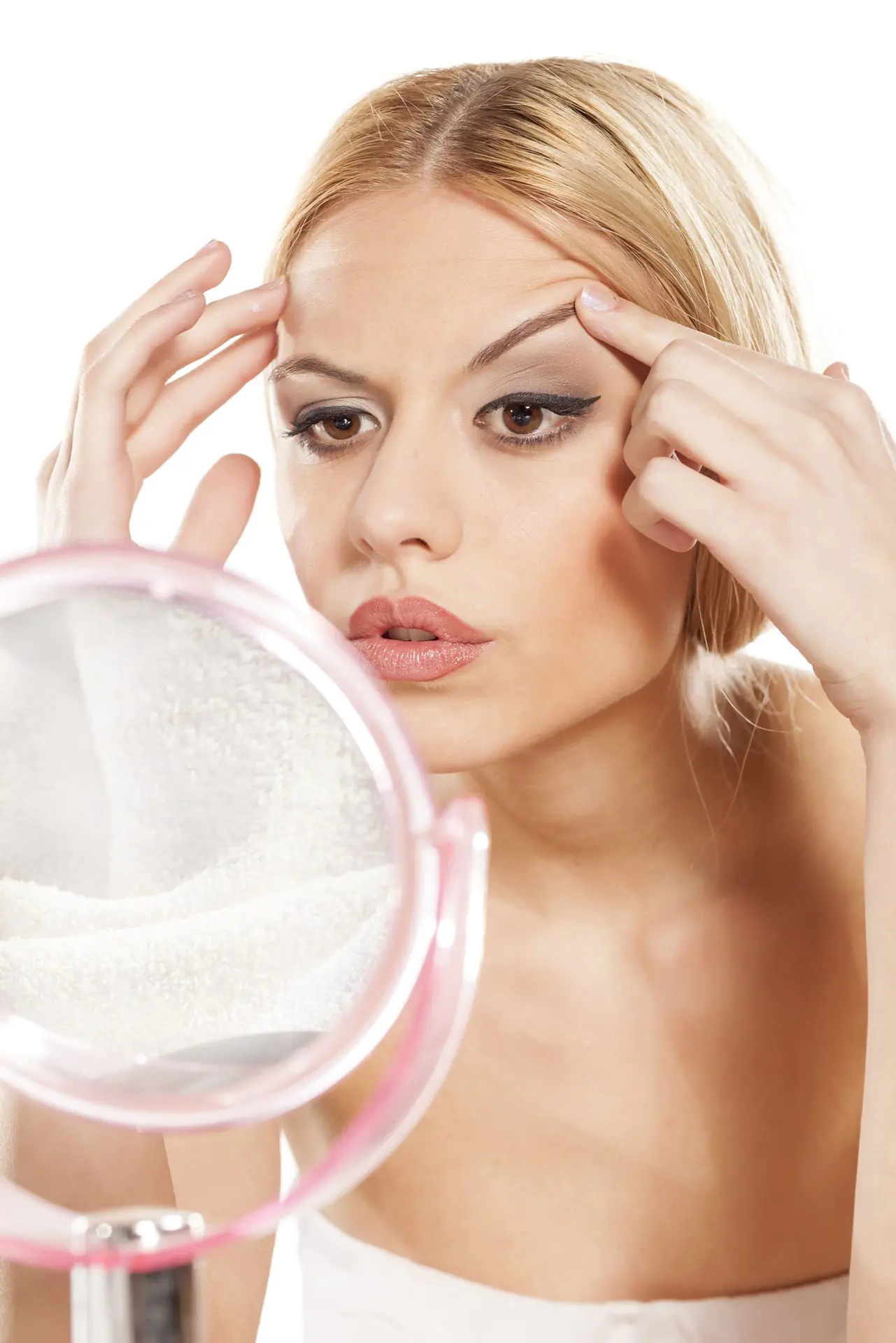
To develop your own strategy for prolonging the youth of your face, it’s worth taking a closer look at why wrinkles appear.
Harmful effects of ultraviolet rays
The destructive power of UVB and UVA radiation negatively affects intercellular connections, collagen and elastin tissues of the skin, and the very structure of cell DNA.
Active use of facial muscles
Any emotions - laughter, joy, sadness, surprise - leave their imprints on our face, explaining the reasons for the appearance of wrinkles.
Natural physiological processes
Age-related deterioration of metabolism leads to a slowdown in the production of collagen and elastin, which leads to natural aging of the facial skin and the formation of wrinkles.
Constant stressful situations
Internal discomfort, frequent depressive states, stress, accompanied by the release of adrenaline, force the body to donate blood and necessary substances to vital organs, which leads to loss of elasticity and freshness of the skin, and the appearance of wrinkles.
Presence of diseases of internal organs
During the period of illness, the body tries to redistribute its forces, feeding the diseased organ with microelements and vitamins. During this period, the skin does not receive the necessary energy and nutrition, which is why wrinkles appear.
Drastic weight loss
The choice in favor of a beautiful waist through diets and fasting often requires a high price in the form of dehydrated skin with unwanted traces of sudden weight loss: sagging, wrinkles, folds.
Lifestyle
Bad habits, passivity, insufficient rest and sleep - all these causes of wrinkles are aggravated by poor ecology and negative external influences.
Non-professional skin care
Incorrectly selected cosmetic products will not only be ineffective, but can also cause significant damage to your skin, accelerating the aging process.
Having become familiar with the main causes of wrinkles, you can develop your own algorithm to prevent the growth of signs of aging and aging of the skin. But professional procedures in our salon will help restore your face to its former freshness and youth:
How can you contact us?
Call: +7 495 555 40 63 or +7 925 343 20 20
We accept for payment: 


Sometimes the most obvious things in life happen unnoticed. We see a lot of wrinkles every day, but ask anyone to define them and the answer will always be: “Everyone knows what wrinkles are.” It is necessary to look at the anatomy of the skin to understand the root causes of wrinkles, which often resemble a hole in a donut, existing only because of its surroundings.
Wrinkles originate in the papillary dermis as a result of decreased elastin production or changes in its structure. These changes are difficult to see on a histological picture even to a trained eye, but their result is reflected in the skin: tone and elasticity are lost, which is why the skin looks dull.
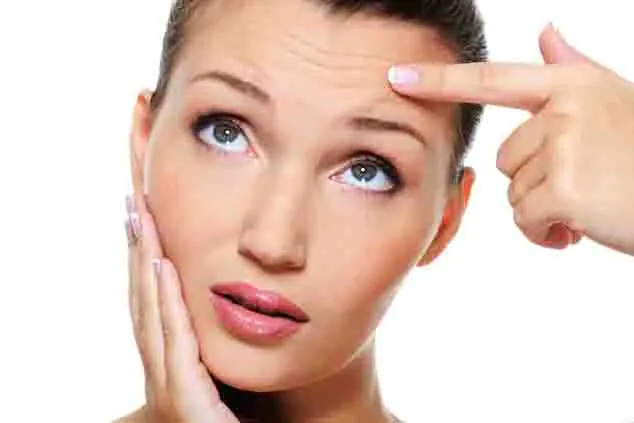
Compare the skin of a healthy child with the skin of an adult and you will immediately notice the difference. In addition to this subtle microscopic change, a number of discoveries related to the origin of wrinkles have been made public.

Theories of facial skin aging
There are two theories of aging: the biological clock theory (chronoaging) and the environmental theory. The first theory states that aging is a physiological process that is programmed into DNA and is reflected at certain periods of life. Old age is understood as the last, final stage of tissue change. The onset of puberty and graying of hair are two inevitable events that happen in the course of time.
The lifespan of artificially grown mammalian cells is often limited to 50 cell divisions. Grown in tissue culture, skin cells taken from older individuals divide less frequently than cells from younger individuals. There is obvious truth to this theory, but it does not explain the variations found between different ethnic groups or adherents of different lifestyles.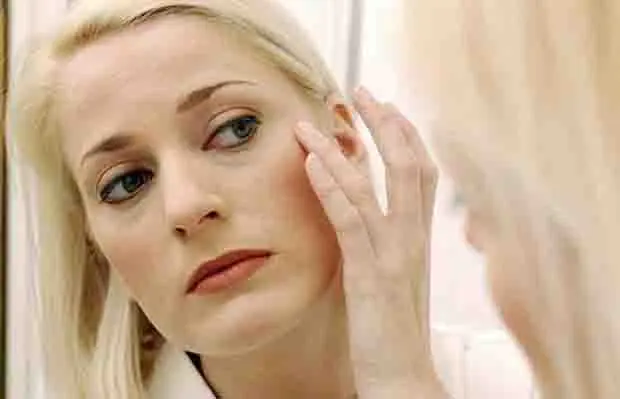
Environmental theory is a complex theory, but its basic idea is that old age is an “accident” caused by the accumulation of biological “mistakes” that a person encounters throughout life. UV radiation, poor nutrition, and psychological and physical stress are known to contribute to aging. Whatever the cause (or causes), the ultimate result of aging is a decline in the body's functional ability to sustain itself and repair itself.
Skin aging pattern
Aging skin is characterized by many physical factors, but the most obvious cause is loss of elasticity, or turgor. The color fades due to the loss of reflectivity of the skin, its surface is no longer smooth, and pigmentation appears. Each of these characteristics represents a specific physiological or anatomical change. Let's consider each of them, but separately highlight the loss of tone.
Physiological changes during aging of facial skin
Skin color is a composite phenomenon resulting from the following factors: blood flow, skin pigments such as melanin, carotene, bilirubin and oxidation products, the condition of the outer membrane of cells and the presence or absence of various skin lesions.
Melanin content decreases with age, and oxidizing pigments, called lipofuscins or aging pigments, increase. Reduced blood flow is not a major factor when it comes to the face, but it greatly affects the skin of the arms and legs. Cells in the surface layer of the skin increase in size and lose their reflective ability, as does the thinning epidermis.
Anatomical changes
As the skin ages, the anatomical dermis becomes less elastic and responsive, as well as drier. The immune response slows down and becomes less accurate. In general, there is a decrease in the ability to effectively self-heal. Fibroblasts lose ground; for some time they continue to produce collagen and elastin, but only in the superficial layers. All this leads to the formation of wrinkles.
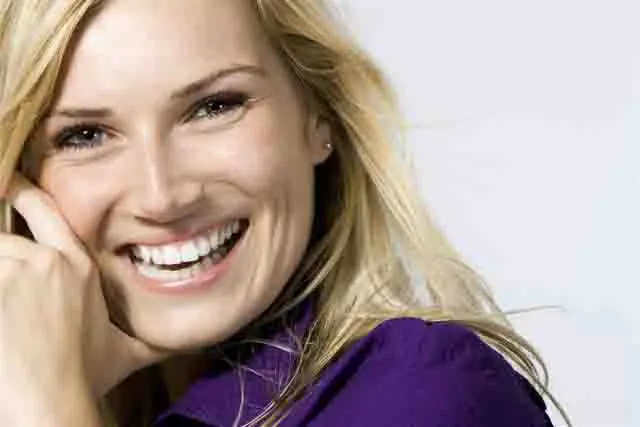
We begin to grow old at the moment of birth - this is the aggressive external world with which we fight all the years of our lives. Age-related changes are practically absent until about 25 years old, when the first signs of aging appear: eyebrows move down, the fat of the lower eyelid begins to hang due to a decrease in elastin production, forming bags under the eyes.
At the age of 30, nasolabial folds increase in depth and length, which about 10 years later are joined by “crow’s feet” and wrinkles on the forehead. Some people see these signs much earlier. At 50, nature begins to take its toll and we see a drooping nose, drooping corners of the eyes and wrinkles around the mouth and neck.
Fat absorption now occurs in such a way that the cheeks recede, the eyes become smaller, and the bone mass of the skull decreases. Excess skin forms into folds, creating a complex pattern of wrinkles. Those who are often exposed to the sun develop many dark, deep wrinkles.
Our muscles and wrinkles on the skin

There are three types of wrinkles:
- Superficial wrinkles - a dense network of shallow wrinkles, usually found in the age group over 70 years or earlier in the case of photoaging (exposure to the sun).
- Cross wrinkles - deeper wrinkles, usually forming on the cheeks and neck.
- Deep wrinkles - these are the most problematic folds of the skin, which form a clearly defined straight line or groove.
All wrinkles are caused by a loss or change in the structure of elastin, but the problem can be aggravated by further changes in the dermis. Try to imagine wrinkles as the visible result of the destruction of the base: in places where the skin is very thin, we see the smallest wrinkles, because the skin can be easily damaged. Deep wrinkles can only form on thick skin, which is why skin that has been exposed to intense sun exposure develops such pronounced wrinkles.
The skin is held on the body by fascia - strong sheets of fibrous tissue that connect the dermis to the muscles. When we smile, the skin is moved by the muscles around the mouth. 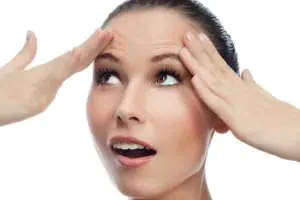
If there is excess inelastic, loose skin, it will fold, causing deep wrinkles. Wrinkles never decrease when a muscle contracts—they can only become more pronounced and deeper. The wrinkle always runs perpendicular to the long axis of the muscle. Contraction of the muscle shortens its length, which, in turn, leads to the formation of numerous folds of aging skin. Thus, muscle contraction will only make the wrinkles more noticeable and deeper.
Known causes of wrinkles
Many physiologists believe that wrinkles are not necessarily a normal consequence of the aging process. On the contrary, the evidence clearly points to environmental influences, and the main one of this group of factors is ultraviolet radiation. It has been established that excessive sun exposure is the main cause of wrinkles. There is an assumption that visible light can also harm the skin.
The main target of high-energy ultraviolet photons is the DNA molecule. The energy of UVB rays (length from 290 to 320 nm) has both direct and indirect effects on the DNA molecule. In the case of direct influence, photons interact directly with DNA to change the structure of the molecule. This often leads to cell mutations and cancer.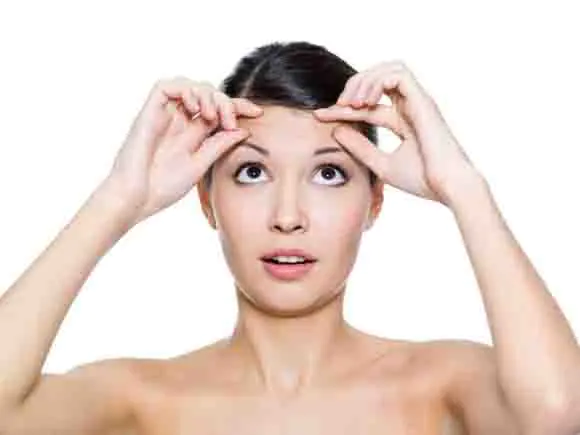
Along with UVB rays, UVA rays (length from 320 to 400 nm) can also have an indirect effect. Photons react with biological molecules that enhance photosensitivity (flavin compounds and porphyrins). These are intensely colored molecules that serve various functions in the body. This interaction produces a type of free radical that can interact with DNA.
Smoking cigarettes generates an astronomical number of free radicals with every puff. Approximately this number is 1x1017. To understand the scale, imagine that one free radical is a large carpenter ant, while the number of free radicals released in one puff is the equivalent of 100 billion truckloads of ants. It is not surprising that smoking has such a negative effect on the skin: the body simply cannot cope with damage of this magnitude.
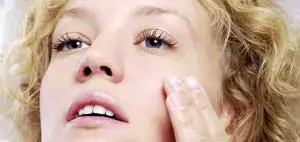
Insufficient intake of nutrients deprives the body of essential supporting and restorative substances. Vitamins and minerals are needed in sufficient quantities to compensate for the effects of poor nutrition.
Excessive calorie intake also has an impact on the aging process in general, as demonstrated by subjects who restricted their food intake and lived significantly longer than another group that ate a lot of calories. How this relates to skin health is not yet known, but it must be related to increased oxygen consumption throughout the body, which also means an increase in free radicals in the skin.
Aging and skin color
The main pigment of the skin is melanin, its role in the aging process remains a mystery. Graying of hair is a sign of aging because... melanocytes are no longer found in the hair follicle. Why? What starts and stops this process? Melanin can scavenge free radicals, but more evidence suggests that antioxidants are the real protective agents.
Melanin also absorbs various forms of energy, including UV rays, and releases this energy as heat. However, when there is too much energy to absorb, melanin produces free radicals on its own! What is the real role of melanin in the body is still unknown. Why there are fewer melanocytes in aging skin is also a mystery.
Time and skin
Skin is changeable. It changes constantly, and this means that it can be influenced both from the outside and from the inside. Physiological changes are often slow and imperceptible, and only in the case of diseases do we notice active visible changes. As age-related changes progress, they can be slowed, stopped, and hopefully even reversed.
I hope this information will help you understand the causes of facial skin aging! Your Super Cosmetologist!
In this article you will learn how and why does the face age, as well as where wrinkles, folds, swelling and other unpleasant changes on the face come from.
Why do you need this information?
- Firstly, so that you clearly understood, which rejuvenation methods work and which don’t, which ones are dangerous and which ones won’t harm.
- Secondly, so that you don’t just mechanically perform gymnastics exercises for the face, but do it consciously, understanding how every movement rejuvenates your face.
I. WRINKLES
Let's start with wrinkles, because these are the most common age-related changes that women experience.
How and why do wrinkles appear?
To understand the causes of wrinkles, we need to understand how the facial muscles work.
Why are we talking about muscles? Do wrinkles form on the skin?
It's simple. The fact is that almost all areas of the facial skin attached by tendons to muscles, and there are more than 55 of these muscles on the face. If the muscles under the skin are healthy and relaxed, the skin is in an excellent toned (tight) state.
But when we experience some emotions, we tense our muscles, for example:
- We smile - the zygomatic muscles, the muscles of laughter, and the muscles responsible for squinting the eyes contract.
- We frown and raise our eyebrows - the frontal muscles contract
- We squint our eyes - the orbicularis oculi muscles contract
When muscles contract, they decrease in size. But our skin can’t do that; it can’t shrink several times in size. And the only thing left for her is to gather into small folds, which we call wrinkles. This is how most facial wrinkles appear. Here's a simple illustration:
This is how horizontal wrinkles appear on the forehead
If, after such tension, the muscles relax and return to their original position, the skin straightens out again, and no unwanted changes occur on the face. That is, we frowned - wrinkles appeared on the forehead; we relaxed our forehead and the wrinkles on our forehead disappeared.
However, often, for a number of reasons, the facial muscles do not relax and are fixed on the face in the form muscle spasms and tension. That is, the muscles in this case are in constant overvoltage. And the skin, accordingly, is also constantly in a wrinkled state. It is in this case that both fine and deeper wrinkles appear on the face.
As a rule, the situation is complicated by the presence bad facial habitssuch as pursing your lips, squinting your eyes, frowning your forehead... And such constant actions only strengthen wrinkles in the corresponding areas of the face.
For example, if we have poor vision, we constantly squint, as a result the orbicularis oculi muscles become overstrained - and this is the main reason for the appearance of “crow’s feet” and other small wrinkles in the eye area:
This is how crow's feet appear
How to remove wrinkles?
To remove wrinkles in an environmentally friendly way, you need to eliminate causes their appearance, namely:
- Relax tense and spasming muscles
- Ideally, to prevent overstrain of the facial muscles in the future
The working algorithm here is as follows:
- Activating tight muscles. First, using specially designed exercises, we set the spasmodic, overstrained muscles in motion in order to pump blood through them and warm them up. This way we prepare them for relaxation and stretching, and also ensure the safety of all subsequent actions.
- Relaxing the muscles. After activating and warming up overstrained muscles, we relax them using special relaxation practices and self-massage techniques. Even if you only perform relaxing practices, you can already remove wrinkles from many areas of your face. But it is much more effective to perform all the practices in combination.
- Stretching the muscles. Finally, we stretch the warmed and relaxed muscles, thereby restoring their natural state and position and helping them to free themselves from toxins and lactic acid that have frozen in them.
- We tone antagonist muscles. If we work with muscles for which there are antagonist muscles (performing the opposite movement), to consolidate the effect, we tone these antagonist muscles with the help of strength exercises in facial gymnastics.
The techniques from the last point are necessary to completely remove wrinkles in some areas of the face. For example, drooping corners of lips and the resultingfolds of sorrow“appear due to chronic overstrain of the triangular muscles, which pull the corners of the lips down. To remove such folds and raise the corners of the lips, we first activate, relax and stretch the triangular muscles, and then we make sure to tone those muscles that are responsible for raising the corners of the lips:
Causes of drooping lip corners and the appearance of “folds of sorrow”
One last point: if the skin has been in a wrinkled state for too long (too long we haven't done anything with our muscle clamps), it could lose its elastic properties. In this case, after removing the muscle tension, the wrinkles may not be completely smoothed out.
This indicates that the skin lacks nutrition and oxygen, and also that the skin is poorly cleansed of waste and toxins. What to do in this case, read on...
II. SWELLING, WORSE SKIN COLOR, LOSS OF ELASTICITY AND TONE
P Why do bags, bruises and swelling occur?
The main cause of swelling on the face, loss of skin tone and deterioration of complexion is lymph stagnation and other liquids. These fluids are naturally removed from the edema area primarily through the lymphatic system: through the lymphatic capillaries and vessels to the lymph nodes. This is how lymph removes toxins, waste, decay products...
But there is one problem here: the movement of lymph through lymphatic vessels and capillaries is carried out mainly due to the work of muscles, because the lymphatic system, alas, does not have its own heart.
What state should the facial muscles ideally be in to ensure sufficient lymph flow:
- On the one hand, the facial muscles must be sufficiently work actively, thus acting as a kind of pump that pumps lymph through the lymphatic system.
- On the other hand, the facial muscles should relax, because overstrained muscles compress the vessels - and the movement of lymph slows down or stops altogether.

How muscles work as a kind of “pump” for pumping lymph
And for most people, as a rule, things are in the most unfavorable way: some facial muscles spasm, while others are practically don't get the load, weaken or even atrophy.
Thus, somewhere there are vessels pinched, and somewhere, on the contrary, understimulated. In both cases lymph movement is disrupted. As a result, the skin is not cleansed enough and becomes flabby, dull and dry. Due to the stagnation of toxins and decay products, blackheads, pimples, spots and other signs of aging appear on the skin. Due to loss of elasticity, the skin sags, swelling, jowls and double chins appear.
III. DEGRADATION IN SKIN QUALITY, LOSS OF ELASTICITY AND TONE
Such phenomena occur if the skin lacks nutrition or oxygen, or if skin cleansing deteriorates due to disruption of the lymphatic system.
We discussed the reasons for the disruption of lymph flow above. But the deterioration of nutrition and oxygen supply to the skin is caused, oddly enough, by exactly the same factors.
Nutrients and oxygen are delivered to the skin through blood vessels and capillaries, which (like lymphatic ones) first pass through the muscles and only then reach the skin. Therefore, overstrained muscles partially or completely block the blood flow through the capillaries passing through them. Weakened and atrophied muscles, on the contrary, do not provide sufficiently active work.
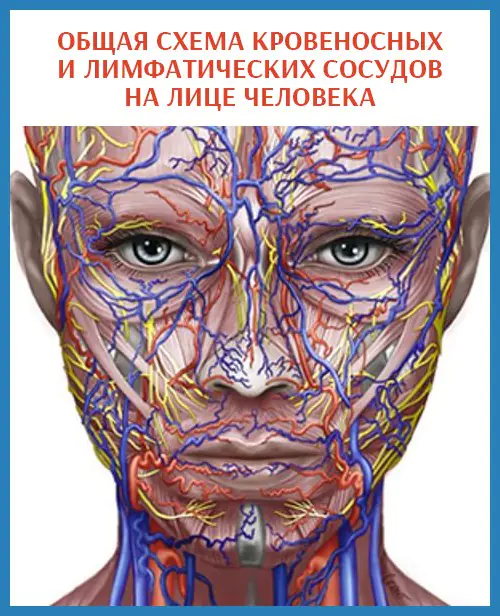
How to remove swelling and return the skin to its natural color, elasticity and tone?
I think you already understand everything perfectly:
- Weak muscles on the face we train and tone with the help of specially designed gymnastics exercises for the face.
- Overstrained muscles first we activate, then we relax, and then we stretch, returning them to their natural state.
IV. FACIAL ASYMMETRY
If facial asymmetry is not congenital and is not caused by injury, its cause is always that symmetrical muscles in the right and left parts of the face are in different states.
For example, if the zygomatic muscles on the right are more tense than on the left, a curvature of the mouth appears:
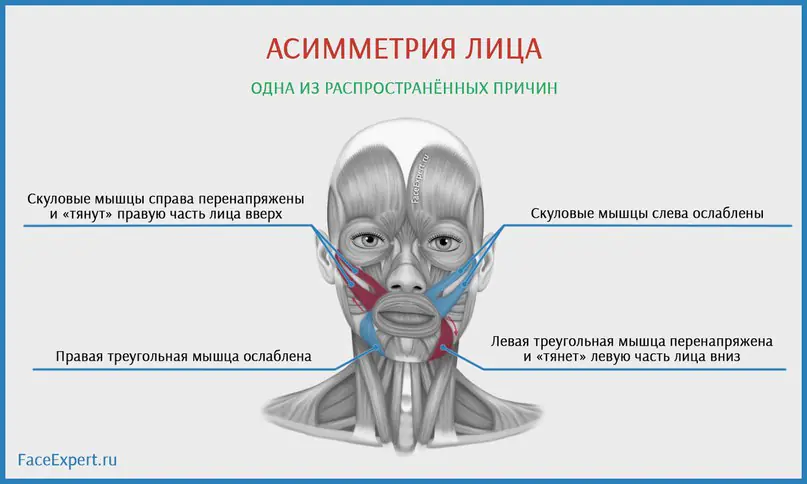
This is how facial asymmetry appears
To get rid of such asymmetry, it is necessary to tone weakened muscles and relax overstrained ones.
V. FOLDS AND SAGING ON THE FACE
Why do deep folds and sagging form?
Almost our entire face under the skin is covered with muscles. And the skin not only covers the face, but is also attached to these muscles by tendons. In other words: the facial muscles hold the facial skin in the necessary tension.
If the facial muscles are not used, they weaken And sag. Along with them, the skin sags in those places where it is attached to weakened muscles.
Thus, for example, when the zygomatic and cheek muscles weaken and sag, shaved, better known as “bulldog cheeks.”
The problem, as a rule, is aggravated by the fact that in places where the muscles are weakened, blood circulation and nutrition of the skin, as well as its cleansing, are disrupted. As a result, stagnation occurs in this area, and they, in turn, lead to the formation of excess fat deposits, which further tighten the skin and make the face even more plump.
How to get rid of sweetness and sagging on the face?
Well, here, I hope, everything is already clear for you: we activate and tone weakened facial muscles with the help of facial gymnastics exercises, and also enhance lymphatic drainage with special self-massage techniques.
VI. KEY TAKEAWAY
To restore or maintain the natural youth and beauty of the face, it is necessary to train the facial muscles. In this case, it is necessary to comply balance: on the one hand, give the muscles dosed loadto keep them in good shape, and on the other hand - relax And pull out them, preventing the formation of muscle tension.
VII. OTHER CAUSES OF FACIAL AGING
The problems with the facial muscles described above are the direct causes of facial aging. But there are a number of factors that worsen the condition of the face as a whole. Here are the main ones:
- Poor posture, problems with the spine (stooping, overstrain of the cervical spine, shoulder trunk, spinal diseases). Any problems with the spine, especially in the cervical region, lead to pinching of blood vessels and deterioration of the nutrition of the facial skin, deepening of wrinkles on the neck, formation of a double chin, deepening of the nasolabial lips, jowls, sagging of the oval, swelling on the face. In addition, any curvature of the spine causes uneven distribution of the load on almost all muscles of the body, including the facial muscles. And this can cause muscle spasms and asymmetry.
- Stress, overwork. If a person constantly experiences a lot of stress, lacks sleep and is overtired, this increases fatigue, and therefore overstrain of the facial muscles and aging of the entire face.
- Chronic habits (wrinkle forehead, frown, squint eyes, clench teeth...). Everything is simple here: in the corresponding areas, the facial muscles are even more overstrained, with all the ensuing consequences.
- Psychological factors (restraint of emotions, depression, frequent bad mood, dissatisfaction with oneself, and so on). There is a common misconception that supposedly too active facial expressions lead to the formation of wrinkles. In fact, it’s just the opposite: exactly suppression of emotionsincreases overstrain of the facial muscles. So smile and laugh to your health!
- Aggressive illiterate skin care (selection of cosmetics that are unsuitable for the characteristics of the skin, abuse of products with surfactants, alcohol, soap; frequent peelings, and so on). All this leads to a violation of the integrity of the skin (for example, it washes away the outer hydrolipid layer) and its imbalance (dryness, oiliness, sensitivity), skin diseases, loss of elasticity, and deepening of wrinkles.
- Unhealthy food (abuse of fatty, fried, salty, sweet foods, flour, dairy; insufficient consumption of fresh vegetables, herbs, berries, fruits, etc.). This clogs the body, leads to intestinal dysfunction, disruption of the lymphatic, hormonal systems, other internal organs and ultimately to skin diseases (dryness, oiliness, sensitivity, acne), swelling on the face, hernias under the eyes, “painting bags”, deepening of wrinkles and folds.
- Insufficient or illiterate consumption of clean drinking waterleads to the fact that the skin does not receive sufficient hydration from the inside. As a result, dry skin, swelling occurs, and all aging processes are accelerated.
- Lack of sleep patterns, often sleeping on the side, face into the pillow. This leads to poor posture, deepening of wrinkles, folds, sagging, swelling (especially under the eyes); hormonal imbalance (the production of the hormone melatonin is disrupted) and skin aging.
- Sedentary lifestyle is the cause of a slowdown in metabolism, as a result the functioning of internal organs is disrupted, the body as a whole and the face in particular age faster.
- Frequent work at the computer, eye strain from reading leads to deepening of wrinkles in the eyes, eyebrows, forehead, sagging eyelids and other changes in the face as a whole.
- Problems with internal organs (gastrointestinal tract, genitourinary system, endocrine system; lymphatic system, etc.) lead to skin aging, skin diseases, facial swelling, sagging, deepening folds on the face.
- Habit of sleeping on one side, chewing on one side leads to asymmetry in different areas of the face.
- Injections and some cosmetic procedures (for example, chemical peeling, mesoscooter, ultrasound, etc.), tattooinglead to a violation of the integrity of the skin, disruption of the inner layers of the skin, changes in the functioning of the facial muscles, swelling, sagging, deepening of wrinkles and folds.
- Age-related changes can also be aggravated by skull injuries, respiratory problems, malocclusion, dental problems, smoking, alcohol consumption, excess fat deposits, sudden weight loss, illiterate performance of certain massage techniques (for example, Asahi massage), and illiterate exercise. gymnastics for the face (for example, abuse of strength exercises).
VIII. SO MUCH! WHERE TO BEGIN?
Here are some useful links:
- If you want to know what results can be achieved without Botox by performing only environmentally friendly exercises for facial rejuvenation, click on this link.
- If you want to find a lot of high-quality and free materials on natural facial rejuvenation, take a look here.
And, of course, don’t forget to like and share this article with your family and friends!



